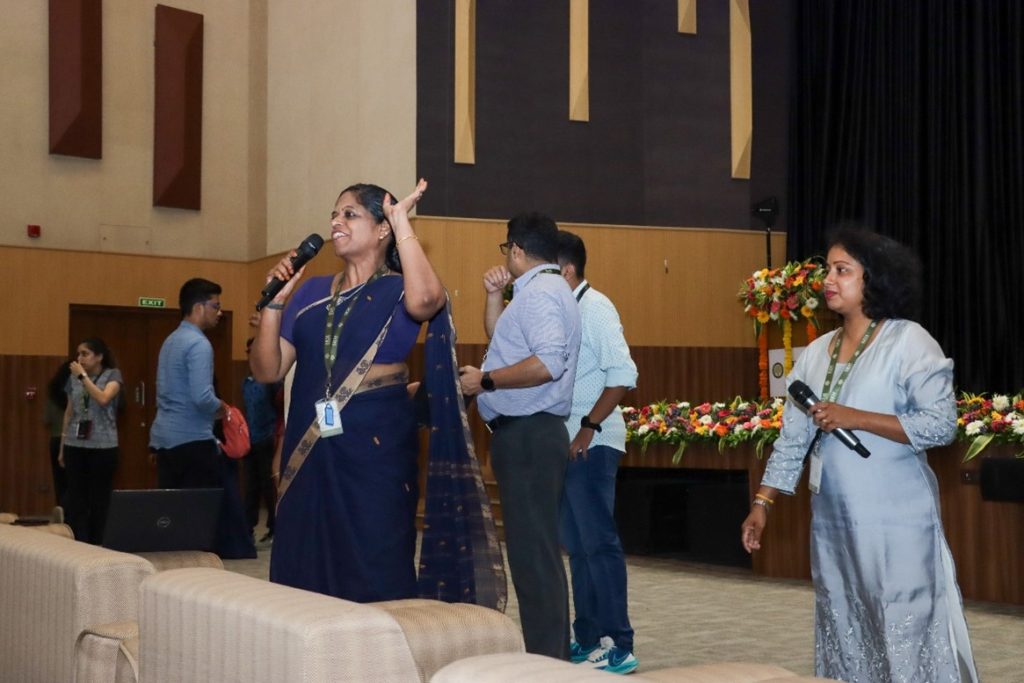All Management Events
- IASc President, Prof. Umesh V. Waghmare Inaugurates Centre of Excellence and Delivers the University Distinguished Lecture at SRM University-AP September 29, 2023
The Hindu
Continue reading →

The Pioneer

The New Indian Express

The Hans India

Rajadhani Varthalu
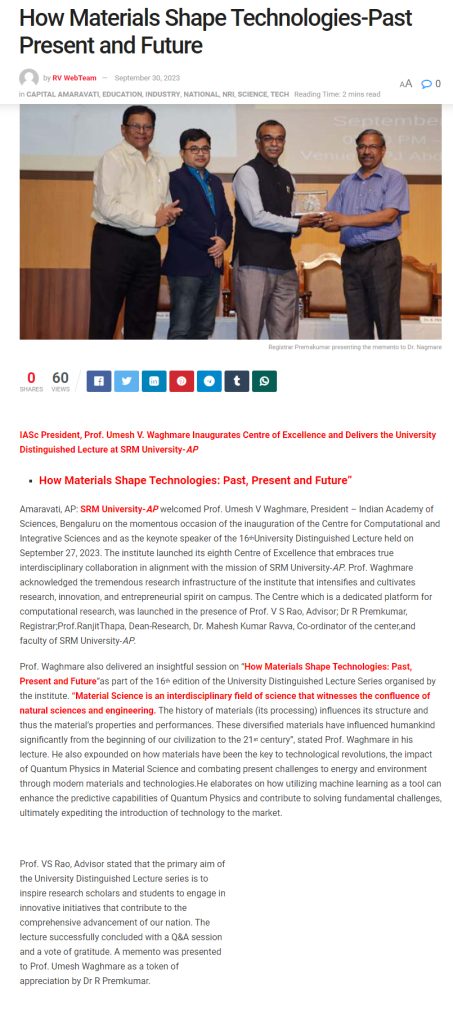
Eenadu
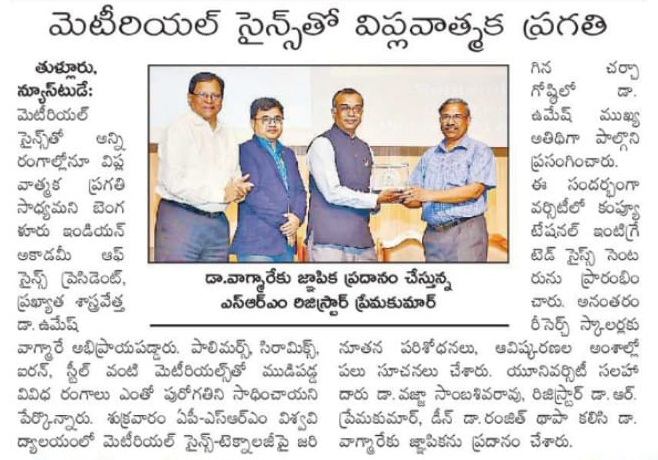
Andhra Patrika
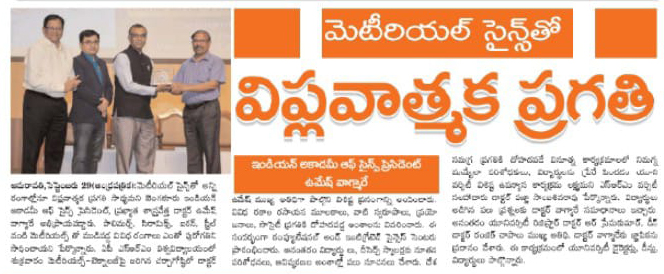
Andhra Prabha
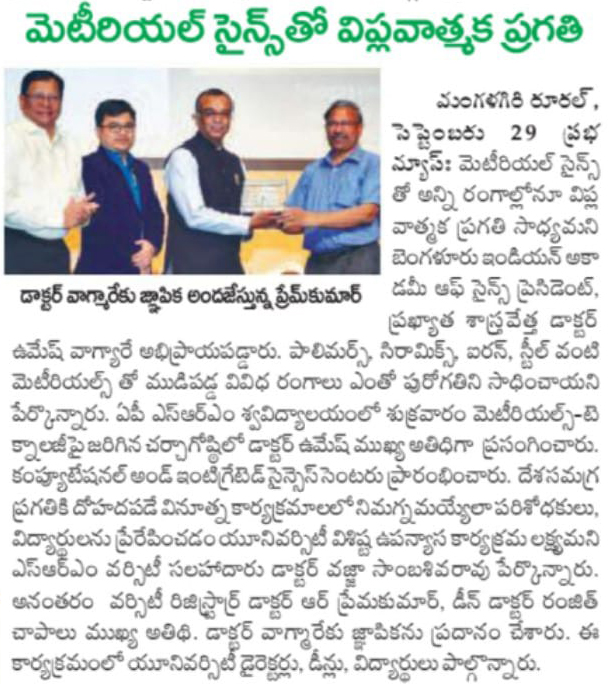
Visalaandhra

Vartha
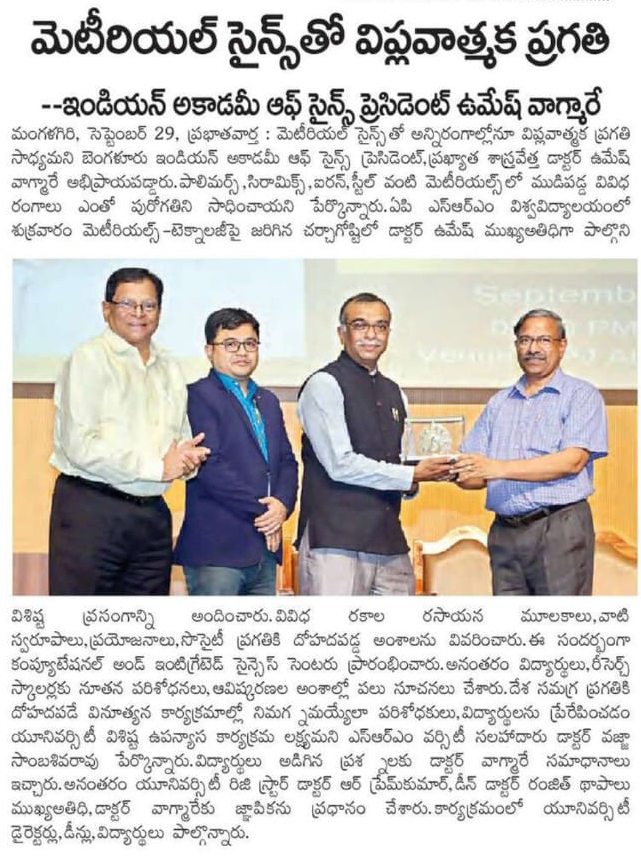
Surya

- SRM AP Educators Accredited with Cambridge Certification September 26, 2023

SRM University-AP educators, Dr Balaguruprasad Narayanan and Dr Anupama Ghattu from the Teaching and Learning Centre are now accredited facilitators under The Cambridge Assessment International Education Program Leaders. The Duo have earned their specialisations in the Teaching and Learning Program & Teaching with Digital Technologies Program respectively.
The certification will enable the educators to provide the faculty and students with specialised competency in teaching and learning mechanisms, it will also facilitate student learning experiences. Following this accreditation, the programme leaders through TLC are planning to guide SRM University-AP faculty members for International Cambridge Certification in one of the above-mentioned programmes of their choice.
Congratulations to Dr Ghattu and Dr Narayanan!
Continue reading → - Skills Diagnostics Assessments For AY 2023-24 September 26, 2023

The Teaching and Learning Centre along with The Directorate of Corporate Relations & Career Services conducted Diagnostic Skills Assessments for Freshman undergraduate students for AY 2023-24 from August 17, 2023 – August 19, 2023, during the Freshman Orientation Programme.
The main objective of the diagnostic assessments was to identify individual students’ knowledge, skills, strengths, and potential areas of growth in English, Aptitude, Math, C Programming, Physics, Chemistry and Biology. It is primarily used to identify and address learning gaps to meet their learning needs. Furthermore, it will also help in tracking student achievements throughout their learning process. The assessment data will be used for differentiated instruction among other techniques in the classroom to foster student learning.
Continue reading → - Growth and Performance of Livestock in Bihar after Bifurcation September 26, 2023
- ICSSR Sanction for Research Project on PM Krishi Sinchai Yojana September 26, 2023

SRM University-AP takes pride in the achievements of its students and faculty. Dr Ghanshyam Pandey, Assistant Professor, Department of Economics and Dr Deep Raj, Assistant Professor, Department of Environmental Science and Engineering were sanctioned a project by the Indian Council of Social Science Research, New Delhi (ICSSR). The research project titled, “PM Krishi Sinchai Yojana- A Step Ahead to Achieve Sustainable Development Goal: A Study of Select Areas of AP, Tamil Nadu and Maharashtra” was sanctioned a total outlay of 16.5 Lakhs for a period of 6 months.
Abstract
Agriculture in India is dominated by smallholders. Yet only about 55% of India’s agricultural land is irrigated. The frequent occurrence of extreme climate events such as drought and heat are some of the main reasons for low agricultural productivity, food insecurity, and persistent poverty in developing nations. In this respect, irrigation plays a significant role in addressing climate change. However, irrigation costs are also very high for small-scale farmers because of their low incomes. Therefore, they do not have the resources to irrigate 100% of their land. In this context, PMKSY is a step towards resolving this problem in India and was introduced by the NDA government in 2015 by Har Khet Ko Pani. Therefore, the present study will examine the coverage, impact, adaptation and constraints of PMKSY in the Indian states of Andhra Pradesh, Tamil Nadu and Maharashtra.
Congratulations on this remarkable achievement!
Continue reading → - Faculty Duo Publish a Critical Analysis and Research on Cyberbullying September 26, 2023

In the digital era, where technology dominates over communication, connection and social relationships, the staggering rise of cyberbullying proves to be detrimental to the social and mental psyche of people. The limited research present regarding the crisis fails to provide sufficient data to critically analyse and initiate policies to combat the same. In this regard, Dr Dhamodharan M and Dr Sunaina K, faculty from the Department of Psychology have conducted insightful research into cyberbullying, the role of technology and the challenges in tackling the act. The faculty duo has published a book chapter titled “Cyberbullying – A Disturbed Psyche and Digital Abuse in 21st Century” in the book In Analyzing New Forms of Social Disorders in Modern Virtual Environments in IGI Global Publishers (US).
Abstract
Cyberbullying is ‘a violent, planned act carried out by a group or specific, using electronic forms of communication, frequently and over time in contradiction of a victim who cannot easily protect him or herself.’ (Smith et al., 2008). According to the UNICEF and Broadband search survey 2023, around 36.5 out of a hundred people feel they were cyberbullied at least once in life, and seventeen percent of people experienced cyberbullying in the last month. 60 out of 100 adolescents experienced cyberbullying. Seventy percent of youths have reported perpetrators. Sixteen percent of women have been stalked at least once in life. 1 in 19 men have been stalked at some point. Fifty percent of LGBTQ people experience cyberbullying. Girls face cyberbullying more than boys. Around 36 percent of girls experience cyberbullying, whereas 24 percent of boys experience cyberbullying. Eighty-three percent of the victims who experienced online bullying also experienced physical bullying. Around 42 percent of the people experience cyberbullying on Instagram, followed by Facebook at 37%, Snapchat at 31%, WhatsApp at 12%, YouTube at 10%, and Twitter at 9%. Cyberbullying refers to using digital technologies such as cyberspace, societal broadcasting platforms, direct messaging, and email to bother, intimidate, or harm others.
This chapter provides an indication of cyberbullying, including its definition, incidence, and impact on individuals and society. Firstly, the chapter reviews the existing research on cyberbullying, exploring its different forms and characteristics and the psychological and social consequences for both victims and perpetrators. Secondly, the role of technology in facilitating and exacerbating cyberbullying is also examined, focusing on the anonymity and distance that online platforms provide. Thirdly, legal and ethical considerations surrounding cyberbullying including the challenges of enforcing laws and policies online are explored. Finally, the chapter highlights the importance of a comprehensive and collaborative approach involving parents, educators, policymakers, and online platforms to address cyberbullying.
Implications
Cyberbullying is a pervasive problem with significant and long-lasting consequences for people, their families, and society. It is essential to address cyberbullying thoroughly and implement effective prevention measures to create a more secure and respectful online environment. Cyberbullying can have detrimental effects on its victims, leading to feelings of helplessness, mental health issues, trouble with schoolwork, and even self-harm or suicide. In addition, cyberbullying affects the social fabric of groups, and trust, and impedes the proper growth of individuals, especially children and adolescents. Cyberbullying has a shocking prevalence worldwide, and it is spreading over to people silently. Traditional bullying differs from cyberbullying; it occurs to the victims in various forms and levels.
Continue reading → - Dr Kaushik Saha September 26, 2023
- Dr Sudeshna Saha September 26, 2023
- Crack the Code of Success with the BSc Mathematics Course September 25, 2023
Your Gateway to a World of Exciting Career Opportunities
In this rapidly evolving world, one constant that has always stood at the forefront of human progress is Mathematics. Usually addressed as the universe language, its value has expanded beyond solving equations or deciphering intricate theorems. Believe it or not, the backbone of advancement is Mathematics, making way for cutting–edge innovations in technology, science, and, of course, our day-to-day lives. As we rush towards the future, the imperativeness of Mathematics becomes even more pronounced. In the world of artificial intelligence, algorithms fuelled by mathematics principles allow machines to learn, adapt, and jump to autonomous decisions.
Whether related to self-driven cars or customised medical treatments, Mathematics is the “X” factor behind these recasting developments.

Believe it or not, the global economy thrives on data, and mathematics motivates us to extract information from data for meaningful insights. Financial institutions utilise mathematical models for introspecting market trends and handling risks. Besides technological and economic implications, mathematics promotes and fosters critical thinking and problem-solving skills. It motivates you to unleash your creativity to reveal the mystery of the universe. Be it from deciphering the cosmos via astrophysics to ravelling secrets of our DNA via genetics, Mathematics gives us the tools to dig deeper and precisely understand the world around us.
Moreover, it is a universal language promoting collaborations and cooperation amongst scientists, engineers, and researchers worldwide, accelerating the pace of discovery and innovation.
Thus, if you love playing with digits, make maths your superpower by enrolling in a BSc Mathematics programme from the best University that fulfils your desire to emerge as the hero of innovation and problem-solving.
BSc Mathematics is amongst the most sought-after courses for candidates after 12th. It has massive scopes and career options, such as mathematics equations, which are used in every step of life.
Scope of BSc Mathematics
A BSc in Mathematics offers a broader range of opportunities and a promising scope for graduates in many fields. Below are a couple of the key aspects of the scope of BSc Mathematics:
- Engineering
- Academic Pursuits
- Teaching and Education
- Actuarial Science
- Data Science and Analytics
- Financial Services
- Computing and Technology
- Operations Research
These are some of the many scopes of BSc Mathematics. However, this is not it; there is much to explore in the course.
Career Options After BSc Mathematics
A BSc in Mathematics opens up a plethora of exciting and diverse career options for graduates. Below are some popular career paths that can be pursued:
- Actuarial Analyst
- Teaching and Academia
- Data Analyst/Scientist
- Financial Analyst
- Market Research Analyst
- Operations Research Analyst
- Statistical Analyst
- Software Developer
The amalgamation of analytical thinking, problem-solving skills, and mathematical expertise opens doors to multitudes of industries and fields where their contributions are highly valued.
Moreover, several high-salaried career paths are available to students after completing BSc Mathematics. Listed below are high-salary courses after BSc Mathematics:
- Master’s in Actuarial Science
- Master’s in Financial Engineering
- Master’s in Quantitative Finance
- Master’s in Applied Mathematics
- Master’s in Pure Mathematics
- Master’s in Computer Science
- Master’s in Data Science or Data Analytics
Subjects in BSc Mathematics
Some of the subjects covered under a BSc Mathematics degree are –
- Mathematics for the Physical World
- Real Analysis
- Probability and Statistics
- Algebra
- Linear Algebra
- Complex Analysis
- Number Theory
- Programming Language Concepts
- Measure Theory
- Optimization Techinique
Open the Door to Endless Possibilities with the BSc Mathematics Programme at SRM University-AP
The BSc in Mathematics programme at SRM University-AP is precisely curated to instill an in-depth understanding of multitudes of mathematical disciplines, readying candidates for endless possibilities. The curriculum is thoughtfully structured, ensuring a magnificent blend of theoretical knowledge and practical applications. From fundamental calculus and algebra to innovative topics, such as number theory and mathematical modelling, this course wraps up a wide spectrum of mathematical fields.
Amongst others, one of the highlights of the BSc Mathematics programme is the emphasis on problem-solving and critical thinking. Mathematics is not just about memorising formulas but developing a keen analytical brain to solve real-world challenges. SRM University-AP fosters this skill by encouraging aspirants to engage in hands-on projects, group discussions, and research opportunities that allow them to apply their knowledge to real-life scenarios.
A programme is only as good as its faculty, and SRM University-AP takes great pride in its exceptional team of professors and mentors. The faculty members at SRM University-AP are highly skilled with immense experience and expertise in numerous mathematical domains, and their passion for teaching ignites the same flame of curiosity in their students. They ensure to go the extra mile so that the students can grasp the nuances of mathematics, making the learning process informative and enjoyable. Below mentioned are some other things that make this University stand out. Have a look.
- Research Opportunities
- Interdisciplinary Connections
- Career Prospects
- State-of-the-art Facilities
Embark on a Journey of Numbers and Possibilities with a BSc in Mathematics
Pursuing a BSc in Mathematics is a rewarding and intellectually stimulating journey opening doors to a world of endless possibilities. Mathematics, often referred to as the “Queen of Sciences,” offers a profound understanding of the universe’s complexities and empowers students and other individuals with analytical thinking, problem-solving skills, and the ability to travel through intricate challenges. If you love how numbers play, enrol for BSc in Mathematics at SRM University-AP.
Continue reading → - Dr Sheetal Yadav September 25, 2023


